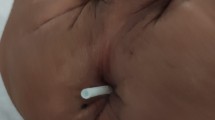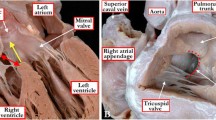Abstract
A 51-year-old man who had been suffering from depression stabbed himself in the chest with an ice pick. At presentation, an ice pick lodged in the left fifth intercostal space was moving synchronously with his heartbeat. Echocardiography revealed that the tip was penetrating the anterior wall of the right ventricle. Because the patient was tamponading, an emergency operation was carried out. The ice pick was removed following the establishment of a cardiopulmonary bypass and pericardiotomy. The perforation of the right ventricle was closed with a pledget-reinforced mattress stitch. On postoperative day 12, a holosystolic murmur was detected on auscultation. Transthoracic echocardiography revealed a ventricular septal defect 5 mm in diameter located near the apex. The pulmonary-tosystemic flow ratio was 1.1 by echocardiographic measurement. No sign of heart failure was present. Although it was agreed to manage the ventricular septal defect conservatively, careful echocardiographic follow-up is mandatory.
Similar content being viewed by others
References
Nishiuchi T, Yokota J, Mizobata Y. An analysis of 20 cases of cardiac stab wound. J Jpn Assoc Trauma 2001;15:251–255.
Yamanaka K, Ishikawa M. Penetrating wounds of the heart. J Jpn Assoc Crit Care Med 1997;11:39–43.
Karrel R, Shaffer MA, Franaszek JB. Emergency diagnosis, resuscitation, and treatment of acute penetrating cardiac trauma. Ann Emerg Med 1982;11:504–517.
Wall MJ Jr, Mattox KL, Chen CD, Baldwin JC. Acute management of complex cardiac injuries. J Trauma 1997;42:905–912.
Cothren CC, Moore EE. Traumatic ventricular septal defect. Surgery 2007;142:776–777.
Tyburski JG, Astra L, Wilson RF, Dente C, Steffes C. Factors affecting prognosis with penetrating wounds of the heart. J Trauma 2000;48:587–590; discussion 590–1.
Arreola-Risa C, Rhee P, Boyle EM, Maier RV, Jurkovich GG, Foy HM. Factors influencing outcome in stab wounds of the heart. Am J Surg 1995;169:553–556.
Asensio JA, Berne JD, Demetriades D, Chan L, Murray J, Falabella A, et al. One hundred five penetrating cardiac injuries: a 2-year prospective evaluation. J Trauma 1998;44:1073–1082.
Lindenbaum G, Larrieu AJ, Goldberg SE, Wolk LA, Ghosh SC, Ablaza SG, et al. Diagnosis and management of traumatic ventricular septal defect. J Trauma 1987;27:1289–1293.
Bryan AJ, Angelini GD, Breckenridge IM. Spontaneous closure of a traumatic interventricular septal defect following a penetrating chest injury. Thorac Cardiovasc Surg 1988;36:172–173.
Author information
Authors and Affiliations
Corresponding author
Rights and permissions
About this article
Cite this article
Ito, H., Saito, S., Miyahara, K. et al. Traumatic ventricular septal defect following a stab wound to the chest. Gen Thorac Cardiovasc Surg 57, 148–150 (2009). https://doi.org/10.1007/s11748-008-0347-3
Received:
Accepted:
Published:
Issue Date:
DOI: https://doi.org/10.1007/s11748-008-0347-3




